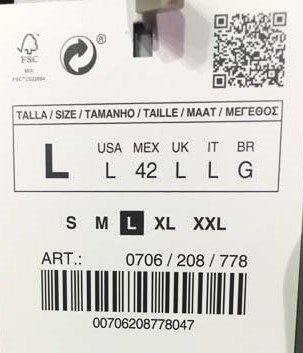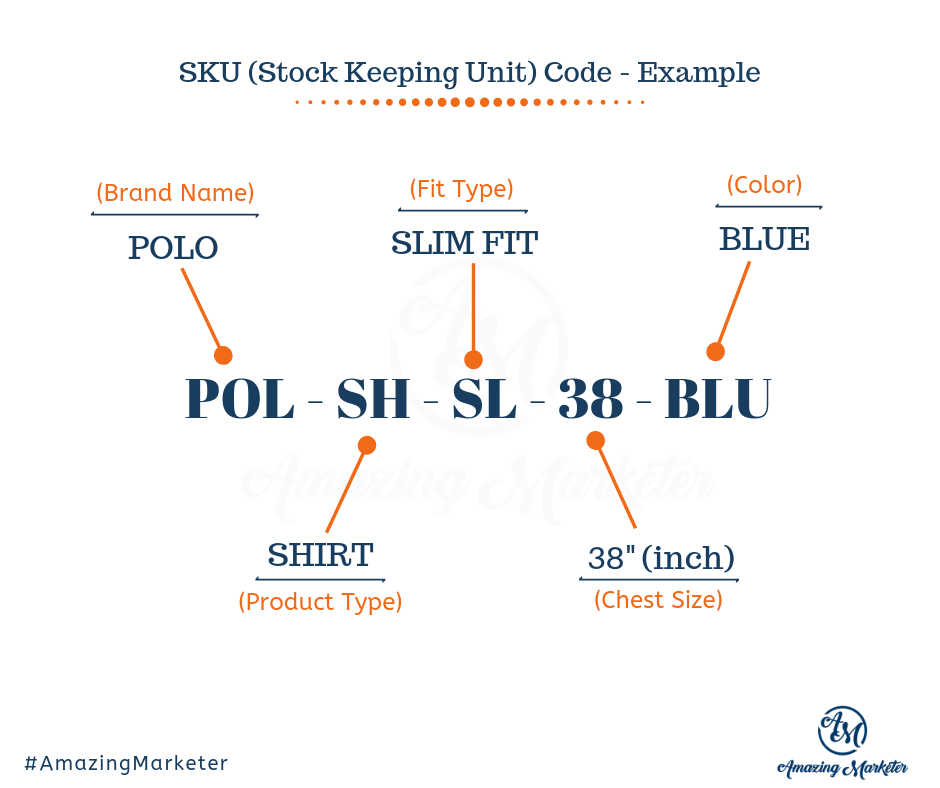As a seller, we all have to keep our inventory up-to-date and a regular check to refill the stock on a timely basis. But, how can we track thousands of product with ease? The answer is SKU code. So, now the question is what is SKU Number or SKU Code?
Table of Contents
What Is SKU Code or SKU Number?
An SKU (Stock Keeping Unit) is an alphanumeric code assigned to a product by the manufacturer, distributor, or retailer to distinguish it from other products in terms of description, brand, size, color, packaging, warranty terms, etc.

A Stock Keeping Unit helps you to track your inventory and its variants easily as it comprises of entire information about the product. Every SKU is unique and with little understanding, you can read them by yourself.
SKU Code Example
As I mentioned earlier, a typical SKU mainly consists of brand name, product description, size, color, material, packaging, and few companies even add warranty as well.
Let me show you an example:

This is how SKU of Polo Shirt look like:
POL – SH – SL – 38 – BLU
- POL – POLO
- SH – SHIRT
- SL – SLIM FIT
- 38 – 38 INCH CHEST
- BLU – BLUE COLOR
You can easily observe that above mentioned Stock Keeping Unit is straight-forward and easy to understand.
How To Create SKU Code?
You can generate SKU codes as per your convenience and logic keeping length of the code and intellect of your staff to understand it quickly. Also, the Stock Keeping Unit should be of an optimal length to make it easy to remember.
You can choose alphabets or numbers or a combination of both. However, I would recommend you to select alphanumeric SKU code.
It is always better to use alphabets & numbers with some meaning instead of random combinations for creating an SKU number that resonates with masses. Here is what it means – bifurcate the digits in such a way that it refers to certain things about the product.
Suppose you want to create 8-digits SKU code, the first two can be used to refer product category, next two digits could refer to the product type, the third two may refer to color, and last two could be the unique identifier.
Step by Step Process to Create a Stock Keeping Unit
Let’s create an SKU code with the basic 3 steps process:
Step #1 – First Level Identifier
The first two or three digits of SKU number should be the highest-level identifier. You can represent a brand, product category, supplier or department by them.
Step #2 – Second Level Identifier
You can use the next two digits to represents distinguish features like color, size, product type, subcategory, etc.; anything that helps you to organize the products efficiently.
Step #3 – Third Level Identifier
You can use a sequence of numbers or date on which product has been procured. This will help you to segregate old items from new ones. To track down the supplier, you can add supplier SKU code in the final series.
SKU Code Example 1: Simple High-level Identifier
A six-digit simple numeric SKU code that uses high-level identifier is shown below:
SKU Code example for Retail Store:
| Category | Category Code | SKU Numbers (Category Code + Sequential Digits) |
|---|---|---|
| Books | 01 | 010000, 010001, 010002 |
| Tablets | 02 | 020000, 020001, 020002 |
| Mobile Phones | 03 | 030000, 030001, 030002 |
| Footwear | 07 | 070000, 070001, 070002 |
| Shirts | 10 | 100000, 100001, 100002 |
In the above six-digit SKU code’s example, the first two numbers signify each category of products in your store. The remaining four digits are a standard number system in sequence. This SKU number system is simple and great until you have more than 99 retail outlets or more than 9999 products in a specific department.
Additionally, you can take out more information from an SKU code if you add more identifiers to it.
SKU Code Example 2: Multipurpose 2-Identifier System
Let’s see an eight-digit SKU number system example comprising of two identifiers highlighting both category and product type.
SKU Code example for Fashion Store:
| Category | Category Code | Item Type | Item Code | SKU Numbers (Category Code + Item Code + Sequential Digits) |
|---|---|---|---|---|
| Shirts | 02 | Slim Fit | 14 | 02140000, 02140001, 02140002 |
| Shirts | 02 | Regular | 15 | 02150000, 02150001, 02150002 |
| Jeans | 07 | Skinny | 24 | 07240000, 07240001, 07240002 |
| Jeans | 07 | Straight | 25 | 07250000, 07250001, 07250002 |
| Trouser | 09 | Regular | 15 | 09150000, 09150001, 09150002 |
In this example, the product category of fashion store is represented by the first two numbers comprising of Shirts, Jeans, Trousers, and so on. And, the next two numbers represent the type of products such as Slim-fit, Regular, Skinny, Straight, and so on. Finally, the last four numbers are in sequence.
In this SKU system, your items need not be category wise. For example,
02150000 = Shirts (02), Regular (15)
09150000 = Trouser (09), Regular (15)
You can see that “Regular (15)” is applicable to multiple categories as it’s a style common in both shirts and trousers. This makes this SKU system easy-to-use and manages item types that have similar features across multiple categories.
This type of SKU system saves a lot of time as staff easily recognize pivotal details of any product in a mere glimpse.
SKU CodeExample 3: Alphanumeric Identifier System
As I said earlier, it’s always best to use alphanumeric SKU code. You can add supplier name or brand name to segregate between various supplier or brand.
Let me show you with an example having 10-digit SKU code for Amazon eCommerce business:
| Supplier | Supplier Code | Item Type | Item Code | SKU Numbers (Supplier Code + Item Code + Sequential Digits) |
|---|---|---|---|---|
| Adidas USA | AU | Shoes | 053 | AU053-0001, AU053-0002, AU053-0003 |
| Amazing World | AW | Toys | 078 | AW078-0001, AW078-0002, AW078-0003 |
| Adidas China | AC | Shoes | 053 | AC053-0001, AC053-0002, AC053-0003 |
| Obama Electronics | OE | Mobiles | 112 | OE112-0001, OE112-0002, OE112-0003 |
| Kidco | KD | Toys | 078 | KD078-0001, KD078-0002, KD078-0003 |
This type of alphanumeric SKU number helps staff to identify the supplier and item type of any product they came across. Also, new and seasonal staff can understand these codes due to their simplicity in catering supplier info and item type within 10-digits.
You can see in the example that there are multiple sellers for the same product. For example:
AU053-0001 = Adidas USA (AU), Shoes (053)
AC053-0001 = Adidas China (AC), Shoes (053)
If you want to stock and track your inventory by supplier instead of product-wise then this is an excellent SKU system to use.
Other Useful SKU Identifiers
In the above examples, you have seen how simple high-level identifiers have been used to create different SKU codes. However, there are many other identifiers that can be used to make your operations smooth and efficient. For example:
Shop or Place Identifier
If you own more than one shop or sell items online or physical marketplaces, you can use shop identifier to track inventory as per shops. Even if you are not selling from multiple shops but planning to do it future, you can use this SKU code system. Simply, keep this shop placeholder blank in the SKU framework for future usage.
Variation Identifier
If you want to track which colors and/or sizes are in demand among your customers then, this identifier is the key to your success. Adding this identifier is super easy in the existing SKU code. For example:
02150000M = Shirts (02), Regular (15), Medium (M)
09150000L = Trouser (09), Regular (15), Large (L)
This identifier will be helpful for both your customers while shopping and staff for tracking inventory.
Sub-category Identifier
Add a sub-category if you want to track your inventory at greater detail to your SKU number. For example, if you have ice-cream parlor, you can add a numerical code for sub-categories such as ice-cream bars, ice-cream tubs, ice-cream sticks, and so on.
What Are The Benefits of SKU Numbers?
Now, you know what is SKU number and how to create it? Let’s discuss the benefits of SKU codes:
#1 – Simplified Communication
The first & foremost advantage of using SKU codes is that communication is short and simple. Every internal staff or employee can understand the product & its type and track its movement.
#2 – Minimize Mistakes
Long or lengthy product names and attributes always cause communication errors. Thus, I would recommend you to use short and simple SKU codes.
#3 – Stock Mapping
SKU numbers help to identify different versions of products and tracking the same with actual stock levels become a piece of cake.
#4 – Product Prioritization
SKU codes allow you to prioritize your products on the basis of popularity considering colors or size combinations. Thus, you can order your next inventory on the basis of popularity to increase your profit.
#5 – Inventory Optimization
Once you figured out the most popular products among the customers, you can then set a reorder status on each version of your stock keeping unit to keep your inventory up-to-date.
Do’s and Don’ts For SKU Number
Before creating any SKU number, you have to identify the audience and need of SKU numbers. Here are the basic do’s and don’ts you should consider:
SKU Code Do’s
- Use both numbers and letters i.e. SKU should be alphanumeric.
- Keep SKU for internal tracking and monitoring purpose only.
- Keep it short & simple.
- Do keep it short, but not very short that instead of helping you it creates confusion.
- First 2-3 digits should be the highest level category.
- Start your SKU codes with letter(s). It’s easier to recognize and sort in spreadsheets.
SKU Code Don’ts
- Never reuse the same SKU for different products.
- Never start SKU with zero or number or character or letter that are visually similar. It will create confusion among humans or software.
- Don’t use special characters like @, #, $, /, etc.
- Don’t use a manufacturer’s code.
What Is The Difference Between SKU, GTIN (UPC, EAN, ISBN), and ASIN?
SKU (Stock Keeping Unit)
Stock Keeping Unit (SKU), is an alphanumeric code assigned to a product by individual companies for storing inventory and tracking internal operations.
SKU numbers are the identifiers that make sense to you and your staff only. It helps you to sort, report, and analyze product data as per your requirements.
GTIN (Global Trade Item Numbers)
You may also encounter another identifier – GTIN. It means Global Trade Item Numbers. GTIN primarily comprises of 12 digits in the United States and 13 digits outside North America. It can be short up to 8 digits for smaller products.
Amazon considers it as a standard product identifier thus you have to submit it for selling while listing your products. By providing this code to Amazon, it reflects that you are matching the universal industry standard as a seller.
Based on the type of product, there is a different type of GTIN. Few common types are:
- European Article Number (EAN) – It is 12-13 digits of barcodes for product identification. This code represents the product, its features, and its manufacturer.
- International Standard Book Number (ISBN) – It is a universal product identification especially for books. The code used to be of 10 digits before January 1, 2007, but now its of 13 digits. It is a mandate to print ISBN number above the barcode or on the back of the book.
- Universal Product Code (UPC) – It is a 12 digit code akin to EANs, that identifies retail products in the US and North America. The key difference between UPC and EAN is UPC is mostly used in North America with 12 digits and EAN with 13 digits used the rest of the countries except North America.
ASIN (Amazon Standard Identification Number)
Amazon Standard Identification Number (ASIN) is a 10 digit alphanumeric code given to every product listed on Amazon. ASIN is unique in nature and no two products can have the same ASIN in any circumstances. Amazon uses it for indexing catalog pages and it is a great help to customers to search a particular product.
What Is The Importance Of SKU Code For Amazon Seller?
Now, you are equipped with knowledge of SKU code and it’s generation. Let’s check out what is the importance of SKU number to Amazon seller.
#1 – Profitability
If you keep a proper record of SKU codes, you will be able to able to identify the most selling product and less selling product in your stock.
#2 – Inventory Management
Maintaining inventory and managing day-to-day tasks becomes easier by using SKU codes. You can easily and quickly identify products in your inventory. Based on this, you got to know how much and which items you have to procure to keep the inventory up-to-date.
#3 – Inventory Monitoring
SKU helps you to consolidate the sold products with remaining unsold products in your inventory. It will also help you to identify products for which refund needs to be initiated.
#4 – Stock Fulfilment
SKU helps you to raise queries in your inventory management software. You can quickly identify when you need to reorder your products as it indicates the possible low stock beforehand.
#5- Product Leakage or Shrinkage
You can easily track any shrinkage or leakage in your inventory by using SKU numbers. It helps you to de-list damage items or track lost items or discarding items which are not saleable anymore.
Conclusion
SKU codes are an astoundingly powerful tool that helps you to organize, track and identify inventory. It also helps you to make smarter procurement decisions. It is a win-win tool for you and your floor staff.
——– If you still have any concern regarding Amazon or any other Digital Marketing strategies, ASK THE QUESTION in the comments below ——–









